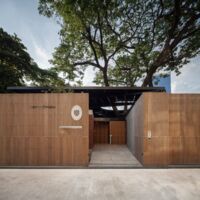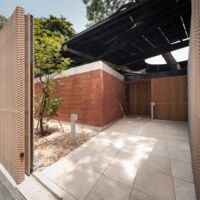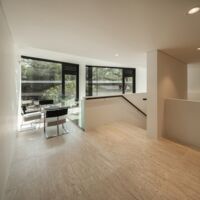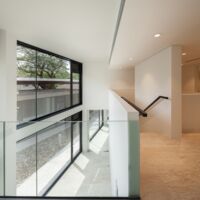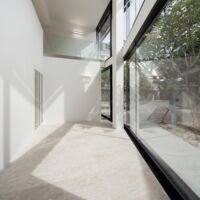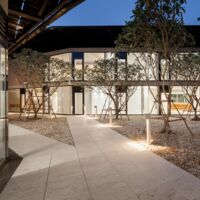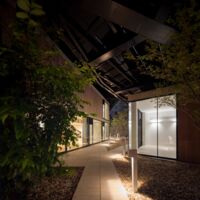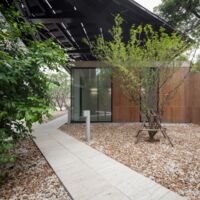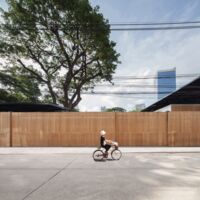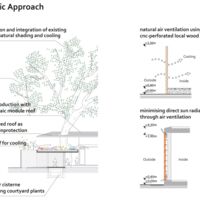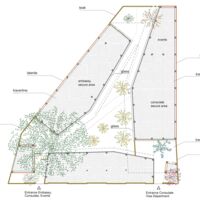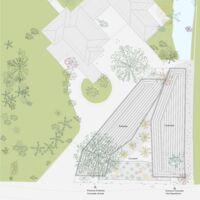austrian embassy bangkok
An embassy building, representative of one nation in another cultural area, therefore acts as an important social, cultural, and technological link respecting the characteristics of both countries results in a symbiotic space. In this particular structure, Austrian achievements in research, energy, and technology mesh with the culture specific Thai way of living and related building traditions.
Respect for social features of Thai life and analysis of traditional Thai building typologies, were the points of departure for the design process. The main challenge was integrating Thai ways into the requirements of a high-security office building based on European standards, alongside special energy solutions to meet climatic factors like high temperature, high humidity, and heavy rainfall. A common space is included in the form of a main courtyard with existing trees and shady areas for social interactions, used by employees and visitors during exhibitions, and it also serves as a protected area in emergencies.
The building’s main traditional resources are detachment, natural airflow, cantilevered roofs, and shady trees. Direct sun has been prevented from affecting the inner construction layers in several ways. A detached steel roof with photovoltaic modules prevents direct sun from heating up the concrete roof, and a detached laterite layer with ventilating airflow keeps it away from the inner prefabricated concrete walls. Existing old trees, which have a high value in Thai society, are integrated into the holistic and sustainable design and used both as landscape elements and for their shading qualities to protect the glass facades from extended solar impact. All glass elements enable high light transmission, low solar energy transportation, and high heat insulation. The correct combination of these three values prevents artificial light during the daytime, thus preventing the inside from getting hot and permitting the building to cool down at night.
For energy production, the photovoltaic roofs work as a solar energy factory; and for reduced energy consumption, the fresh air is cooled down by the main air-handling unit and sent to singlefan coils. No batteries are needed, as the energy is consumed during the day when it is produced. Used air flows from the rooms into the courtyard through overflow louvers and is partly guided back to the fan coil in the suspended ceiling of the corridors. For watering plants in the dry season, a cistern has been implemented under the flat roofed area.
The structural concept of the buildings also follows the idea of sustainability. The structures are designed as concrete skeletons, filled in with local materials. The three materials—laterite (conglomerate stone), teak (from a state-run plantation), and glass/aluminum—are perfect for meeting the concept of a functional envelope. On the outside, laterite and perforated teak create a secure but transparent surface. Glass enables office spaces to extend into the courtyard, creating a pleasant atmosphere for employees and visitors, with a feeling of closeness to nature. Laterite, once used for temples, has an interesting appearance and a wonderful natural red color. Perforated teak is used as an air ventilation element around the courtyard and serves as a protection filter toward the street. Besides its political and cultural importance, the building ensemble serves as an indicator of mutual respect, traditional knowledge, future orientation, energy production, and environmental care.
AWARDS:
- STAATSPREIS ARCHITEKTUR AUSTRIA 2021 Nomination
- EUROPEAN ARCHITECTURE AWARD 2020
- ENERGY GLOBE AWARD 2020 THAILAND
- ICONIC Award Best of Best for Innovative Architecture 2019
- Mies van der Rohe Award 2019 Nomination
- LEAF Leading European Architects Forum Award 2019 Shortlisted
- Architizer A+ Awards 2019 Finalist
- The Plan Award 2019 Honorable Mention
- Green GOOD DESIGN AWARD 2018
- Austrian Green Planet Building Award 2018
2013-2017, Bangkok, Thailand.
1.Prize, EU-wide 2 level general planning tender competition.
BMEIA Federal Ministery for Europe, Integration and Foreign Affairs.
GFA 1.271 sqm.

Program:
New Construction Embassy and Consulate including Outdoor Facilities
Client:
BMEIA Federal Ministery for Europe, Integration and Foreign Affairs, Vienna
Architecture:
Design- HOLODECK architects
Project team - Marlies Breuss, Michael Ogertschnig, Johannes Müller, Suchon Mallikamarl, Peter Hundt, Chloe Priou, Alexsander Garber, Elitsa Tsankova
Consultants:
Structural Engineer - Gmeiner I Haferl, Vienna
Building Physics + Simulation - IPJ Ingenieurbüro P.Jung, Vienna
House Technics - PGG Graz, PSMC Bangkok
Building Contractor - Power Line Engineering
Consultant - Four Aces
Photovoltaic roof - Aero Bangkok
Photography - Ketsiree Wongwan
Scope of work:
HOA/A, §3 (1)-(8); General planning
Dimension:
Floor area 1.271 m2, PV roof 590 m2

